
In tribute to the AC72
Given that, sadly, their days may be numbered, we thought it time to pay homage to the AC72 catamaran, a boat way ahead of its time.
At present it looks as though if Emirates Team New Zealand wins this week, the accountant in CEO/grinder Grant Dalton may well take the 35th America’s Cup back to monohulls, even though the monohull-multihull Rubicon has now been crossed and none of the rest of the Kiwi team – neither sailors, nor designers - seems overly keen to regress back to slow boats.
Dalts has said he intends to be more democratic than the present regime in making this decision and will even consult other potential challengers about the type of boat that will entice the most teams back to the competition. One suspects that they’ll work out what a typical team budget should be and then decide upon the boat that best fits the bill while hopefully finding a way to prevent teams with the biggest budgets from winning. So while we can expect Luna Rossa to challenge the Kiwis within seconds of their winning (should this come to pass), it looks as though it will be a longer wait before the Protocol for the 35th America’s Cup is published.
If Oracle Team USA successfully fights back from the brink – and currently six points behind, that’s a lot of fighting - the indication from the team is that they would consider a smaller, perhaps simpler, multihull. Oh yes, with an Iain Percy-led Artemis Racing as Challenger of Record.
But realistically changing to a new genre of monohull or a smaller multihull will not cause much cost saving. What will is if the design/R&D/engineering element is drastically reduced and this can only be done if the size of the design space is scaled back, if some design avenues are blocked off (more effectively than foiling was this time around...) for example by making some elements of the boat effectively one design.
We hope that the last few days leave an indelible impression on the decision-makers and that the views of the AC72 sceptics have been annulled. The America’s Cup matches have proved that AC72 racing can be both close and fast. Dalton may have made the great comparison between the AC72 and Concorde, in terms of it being ahead of its time and uneconomic, but the America’s Cup is not the airline industry and if there was the will then the cost of AC72 type boats could be reduced considerably. It would be a shame to have yet more redundant technology consigned to the scrap heap with only a few weeks of sailing on the clock.
Nationality
It is likely that whoever wins will reintroduce a nationality rule. We hope that this is not too Draconian and only applies to the majority of the crew, not the entire crew (even Emirates Team New Zealand has allowed two Australians on board this time...) Also if it is applied, then it must refer to the country where individuals were borne, not where they’ve most recently blagged a passport, as has occurred in the past.
Hamsters
Another issue worthy of contemplation is that of the grinders. While watching large lads working up a sweat is reassuring for the soul and is in line with Russell Coutts’ desire for the AC72s to be more athletic, "hard boats to sail", it doesn’t make for overly good television when there are almost never any hoists and drops and certainly no peels; where the grinders appear to be going like hell but with the grind-off ostensibly achieving nothing (they spend the majority of their time cranking up hydraulic pressure – maybe we should show that telemetry data on TV?) One wonders how many crew jobs would be saved by putting on an engine? Maybe the AC72s could become the ultimate doublehanders! Certainly this ‘hamster’ element needs contemplation.
PhD boats
That the Kiwi and Oracle AC72s have ended up being so similarly matched is genuinely surprising given how vastly different they are. Shock, horror - the event has become as much a sailing contest as a design one.
While AC72s may be ‘hard boats to sail’ in terms of the manpower physically required to keep hydraulic fluid coursing through them, they are also very, very hard thanks to their sheer complexity. While on AC monohulls in the past there has been considerable choreography to all the familiar crew manoeuvres – tacks, gybes, hoists, drops and sail changes - AC72 crews may not have sails to deal with, but the boats are even more complex in terms of co-ordination between the crew, making sure every function happens with split second accuracy, that the lift characteristics of the windward and leeward boards changes at the correct moment in manoeuvres; that in tacks and gybes the wing pops and its sheeting, twist and camber come on at the right time; that loads on the wing are not exceeded, whether the rudders and daggerboards are set up and performing in the right way – and, of course, if anyone puts a foot wrong, then there is strong potential for complete catastrophe (as Emirates Team New Zealand came perilously close to discovering).
Added to this complexity is the high pace of development these first and second generation version of the AC72 have seen, not only in their design and equipment, but also in crew co-ordination and the way the boats are sailed. Both Oracle Team USA and Emirates Team New Zealand remain on the steepest of learning curves, particularly so in the case of the defender over the last few days. As Ben Ainslie put it recently in his Telegraph column – before the regatta he thought that they might eek out a further 10% in terms of boat performance, whereas in fact it has been more like 25%...
When they do get racing again, it will be interesting to see which team’s got what left in its armoury, because certainly the Kiwis won’t have been pleased by their performance over the weekend, the first time we have seen them properly being matched for pace around the race course.
While Oracle has clearly gained performance, particularly upwind, the Kiwis have been upping their game at a slower pace continually throughout the competition. For example, unlike Oracle Team USA, their AC72 has had a self-tacking jib from the outset (enabling them not only to sheet on faster in manoeuvres, but also freeing up the hamsters to deal with other functions). Between the Louis Vuitton Cup and the America’s Cup they fitted a kind of foredeck ahead of the mast, acting as an end plate for their jib, similar to the set-up on Oracle’s second boat, this blending in nicely with the jib sheet track.
Other significant differences between the two teams are their foil packages. Aside from the different profile of their daggerboards – Ls, Js, etc - Oracle Team USA is believed to have a hydraulic up/down for its boards, whereas those on the Kiwi boat are operated via a conventional rope purchase. Compared to the Kiwi set-up, Oracle’s is probably slower, but does hold the advantage that the leeward board can be raised while the crew remains to weather. So, there are pros and cons of both systems, each requiring the crew to manage its boards in its own particular way.
Since the dawn of AC72 foiling, Emirates Team New Zealand and Oracle Team USA have approached their daggerboard design and the way they foil from different ends of the spectrum. The defenders started off with straight L-shaped daggerboards, which were less draggy, but also less stable than the Emirates Team New Zealand boards which had a more obtuse angle between the vertical and horizontal components of its boards helping to improve the stability of the ride. Gradually these two opposing positions have evolved, and are now approaching a similar middle ground between their original positions.
Daggerboard movement
The operation of the boards on both boats is fiendishly complex and understanding all they can do and their effect in different conditions, remains a work in progress for the teams.
On both boats – and as is the case with all of the AC72s - the cant angle of the board can be altered via a hydraulic ram that moves the entire daggerboard box. This has the effect of increasing the V-ness of the centreboards making for a more stable ride downwind at the expense of drag, while, upwind, cant is removed so that the vertical part of the board is as upright as possible to reduce leeway.
Obviously reducing leeway is a function of how much board area is in the water, which is why the AC72s usually low ride upwind, except in stronger winds (as we saw over the weekend) when their speed upwind is such that they can afford to foil slightly (their ‘skimming’ mode), reducing the parasitic drag of the hull, while maximising the amount of vertical foil in the water.
Upwind on the Kiwi boat, the weather board is retracted in its canted position to keep it clear of the water, not only reducing its drag, but also preventing the deluge of water constantly being hurled up at the Oracle Team USA crew (noticeably worse than it is on the Emirates Team New Zealand boat). On the Kiwi boat, immediately prior to tacking, the angle of cant on the weather board is altered, bringing it more upright, while during the tack the cant is ‘bled’ on the new leeward board, thereby helping to lift the hull. This enables the ‘foil to foil’ tacks that the Kiwis have been showing great mastery of.
Through clever timing, the Kiwis are also able to alter the cant of their boards generally when the boards are under minimum load, thereby conserving some vital grinder horsepower (the equivalent of sheeting in headsails while being head to wind). The exception is the leeward gate rounding, where outside of Oracle Team USA’s famous ‘foiling tack’, crews have instead preferred to harden up, where the grinders must then bring the boards back up to the vertical for the upwind leg, or leave them inclined until the first tack, thus requiring the boat to be sailed initially in a ‘low mode’.
While typically teams have a single upwind mode and a single downwind mode in terms of how their boards are canted, sometimes if conditions allow (ie they are lighter and more stable) the boards can be canted less downwind, thereby reducing drag, albeit with the increased risk of less stability.
And that’s not all...
In addition to the cant angle of the boards, their pitch (rake) can be adjusted. Various crew have access to changing this, but in particular the helmsmen. Just like the trim tab on a Moth’s main foil, this obviously affects the amount of vertical lift the board generates and is typically used during gybes (to help foil-to-foil gybing) and also to adjust fore and aft trim of the boat while straight-lining. For example upwind in big conditions more rake (ie positive lift) can be dialled into the daggerboards to achieve ‘skimming mode’. This positive lift is also why the AC72s can be safer than other multihulls, encouraging their bows to come up in bearaways or during Emirates Team New Zealand-style bow diving antics.
The amount the rake control is used also depends on the stability of the configuration (ie the amount the boards are canted): The less stable the ride, the more the rake of the boards must be adjusted to maintain the ride height.
Rudders
The rudders have been a particular issue on the AC72. Their rake can be adjusted between races, but not during, the degree of their rake depending upon wind and wave state. Typically lift is dialled into the rudders (thereby pushing the bows down), but this shouldn’t be so much that in the event of the breeze increasing it will cause the boat to develop a bow down aspect that will then need to be righted by increasing rake on the daggerboards, in turn resulting in the foils producing excessive drag.
The size of the lateral part of the T-foil rudders has been continually changing, as typically CFD suggest small Ts, with less drag, while in practice the bigger T-foils offer improve handling and gybing ability and have generally been found easier to use. But this increase in size has created problems, as transpired during the ‘Ruddergate’ incident, due to the T-foils not being allowed to extend beyond the perimeter of the hull, both outboard and aft of the transom. As a result teams have had to carry out major surgery on their AC72s, to move rudder stocks which not only ended up further forward, but also further inboard, ie they are no longer on the centre line of the boat. The rudder stocks are also more vertical than they usually are – on conventional catamarans they are mounted so that they are vertical at the optimum heel angle upwind. On AC72s they are more upright, mounted so that they are vertical when the boat is foiling.
The mighty wings
Thanks to the novelty of getting an 72ft catamaran airborne, the wings seem to have dropped into the back seat of secondary importance to followers of this America’s Cup.
The most significant difference between the wings on the Kiwi and Oracle AC72s is that on the former twist can be induced in the leading element, just like it can be on a C-Class catamaran (where it is necessary, as headsails are prohibited), whereas on the Oracle wing it can’t.
Allegedly Oracle tried twisting leading edge wings on their AC45s but chose not to scale it up to their AC72s, presumably put off by its complexity and causing increased weight aloft.
The arrangement on the Kiwi AC72 is similar in its engineering to a C-Class wing with the twist being induced in the leading edge of the wing relative to a static internal ‘mast’. In comparison Oracle’s wing achieves a similar degree of twist through its second element.
The size of the AC72 wings makes them supremely overpowered, so the twist, mainly induced through the flaps up the trailing edge of the wing (as well as the front element in the Kiwi’s case), is effectively used to depower the wing in big conditions. However the teams using wings without twisting front elements have been finding it necessary to invert the top of their wing to depower it. The downside of this is that inverting the wing creates excess camber low down, in turn creating more drag than the Kiwi set-up where they can keep the foot of their wing relatively flat - this is believed to be why the chord distributions on the Kiwi and Oracle wings vary, with the defender’s having chord less as its the base, in order to minimise drag in this area.
Going forwards
As mentioned, we hope that whoever wins the America’s Cup will have the cajones to stick with a cheaper version of the AC72, one designing some parts of it. However it is interesting to theorise about where these boats might go if they were to be used in a second America’s Cup. Despite the chat, at present the AC72s seem reluctant to spend very long above 40 knots, despite rumours from both teams of hitting the high 40s during training. Presumably a new generation of these boats, even partly one designed, would be faster still, until they hit the 50+ knot barrier, when their foils will start to develop cavitation issues.
Another suggestion has been to scale back the size wing (making the wing’s handling, stepping and unstepping easier) which would place greater emphasis on using headsails and in particular gennikers downwind. However, in turn, this would mean that more money has to be spent on sail development (so back to square one, cost-wise).
A joke going around Cup-land at present is that if the 35th America’s Cup went back to monohulls it would still cost the same, because the sailors would have to be paid more to sail them...
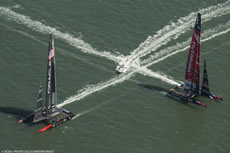 |
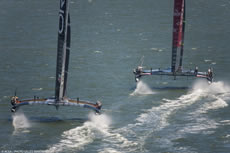 |
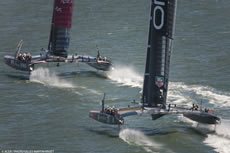 |
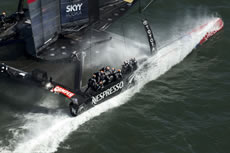 |
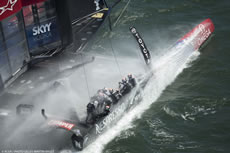 |
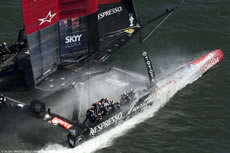 |
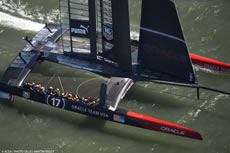 |
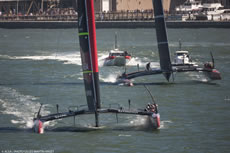 |
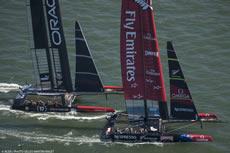 |
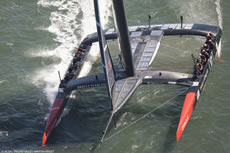 |
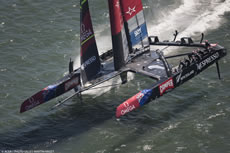 |
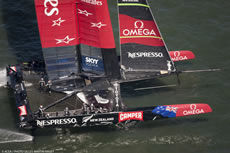 |
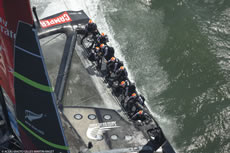 |
 |
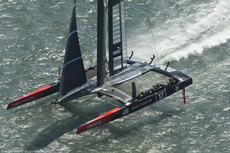 |
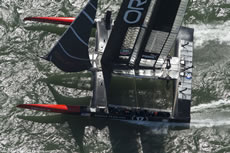 |
 |
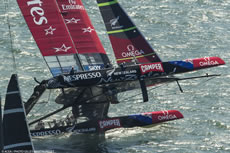 |
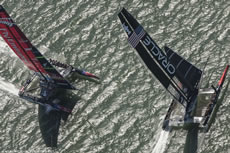 |
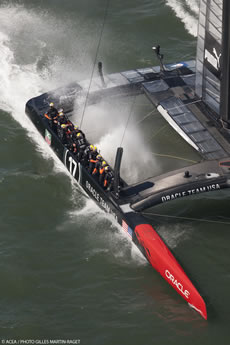 |
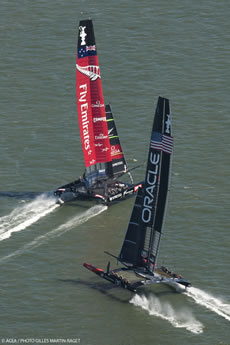 |
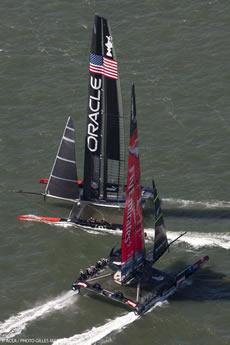 |
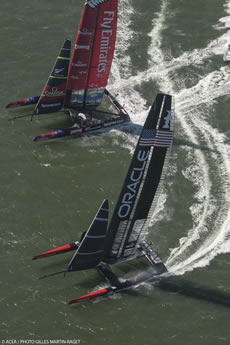 |
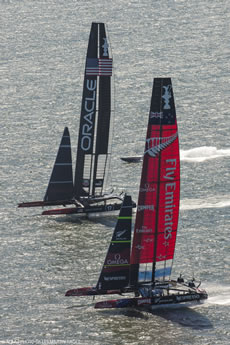 |














Latest Comments
KingMonkey 19/09/2013 - 15:55
Fantastic article. I'm sure I understood lots of it. Fingers crossed regarding some kind of AC60 catamaran for next time. One design foils? Wings? It would be hard to go further.James Boyd 18/09/2013 - 20:24
Nonsense - the pie warmers are what Dean Barker gets to lean on during post-race interviews...Pete Cumming 18/09/2013 - 19:02
Pie Warmers are on the back to channel the air flow off the lower wing & maximise the surface area the air flows over generating more power.Rick Tomlinson ... 18/09/2013 - 16:37
great article James, but what are the "pie warmer" boxes on the aft beam of ETNZ?HieldM 18/09/2013 - 16:08
Don't mind the Hamsters, looks impressive the constant grinding, shows they have to work the boats, and great sound coming off the boats as the hamsters earn their keep. As to one design, the wing is an obvious candidate, the winner can supply the wing cut out all the design and build costs to individual teams and a spare can be available as part of the cost. One point to make if the AC went back to monohulls, what TV footage would a team show to would be sponsors, AC32 or AC34?david_collins 18/09/2013 - 14:44
Fabulous article - many thanks!!!Add a comment - Members log in